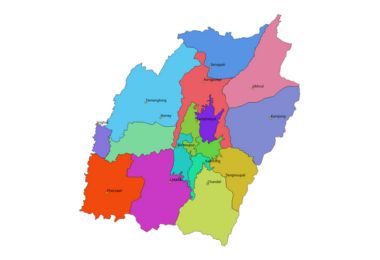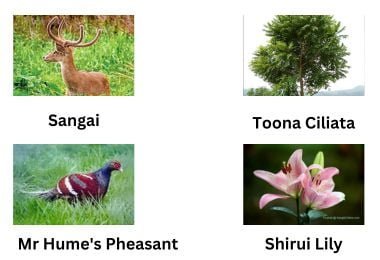Manipur: Jewel of India
Manipur is a beautiful state surrounded by hill ranges and was rightly called the ‘Jewel of India’ by Pandit Jawaharlal Nehru. Known as ‘Kangleipak’ or ‘Sanaleipak’ (golden land) to its inhabitants, it has an area of 22,327 sq. km and is bounded by Nagaland in the north, Assam in the west, Mizoram in the south-west and Myanmar in the east and south-east. The valley is a plateau; its height above the sea level is about 2,600 ft. The hills and mountains of Manipur are offshoots from the Himalayas.

demography
The state has a population of 27.22 lakh according to 2011 census. About 41.4 per cent of Manipuris are Hindus. The Hindu population Text.indd 41 4/27/2017 12:13:35 PM 42 North East India: People, History and Culture is concentrated in the Manipur valley. Christianity is the religion of the majority of the population in the hill districts, where it was introduced by the Christian missionaries in the nineteenth century. In the valley, there is also a section of Manipuri Muslims, known locally as ‘Pangals’ who belong to the Sunni sect.
Manipur comprises 16 districts—Imphal East, Imphal West, Thoubal, Bishnupur, Jiribam, Kakching in the valley, and Ukhrul, Churachandpur, Chandel, Senapati, Tamenglong, Kangkpokpi, Kamjong, Tengnoupal, Noney and Pherzawl in the hills. These districts are divided into sub-divisions and community or tribal development blocks
State symbols
The state bird of Manipur, the majestic Mr Hume’s Pheasant (Syrmaticus humiae), locally known as Nongin, graces Manipur’s landscapes with its vibrant plumage. The state tree, Toona ciliata, stands as a testament to Manipur’s natural splendor. Adding to the state’s botanical diversity is the exquisite Shirui Lily (Lilium mackliniae), proudly serving as Manipur’s state flower. Among the native fauna, the Sangai, also known as the brow-antlered deer (Rucervus eldii eldii) Manipur’s state animal, takes center stage.

Manipur and its love for sports
Manipur has a rich history of traditional games and sports. The modern game of Sagol Kangjei (Polo) is reported to have originated in Manipur. The game is played in both styles—the old Manipuri style (Pana) and the new style (Polo). In the past, it had the support of rulers and nobles. Another popular local sport is Hiyang Tannaba (boat race) normally held in the month of November at the Loktak Lake and Thangapat. The boats used in this game are called ‘Hiyang Hiren’. The people of Manipur believe that the boats are endowed with spiritual powers. Mukna (Manipuri wrestling) is also another popular and highly regarded game, which enjoyed royal patronage in the olden times. This game is played between two male rivals by the display of physical strength and skill. Today, the state is wellknown for its unique and exemplary love for sports. A large number of players from the state represent the country in national games, Commonwealth Games, Asian Games, Olympics, etc. The players participate in hockey, football, boxing, weightlifting, judo, etc. The potential of sports is very bright and with adequate and proper infrastructure, sports can become a major activity for youth empowerment in the state
Manipur: ancient history
Manipur is a fabled state that finds mention in Mahabharata. The archaic literature of the Meiteis, the largest community of the state, preserved in the form of Chietharol Kumbaba or the royal chronicles, claims an uninterrupted line of kings since 33 A.D. However, Manipur appears to have emerged as a well-established kingdom under King Kyamba in 1467-1506. By the early fifteenth and sixteenth century, Manipur was distinguished by the presence of a well-developed formal power structure and cultural symbols.
The subsequent 150 years witnessed Burmese invasions, with King Alungpaya’s occupation in 1752. Internal conflicts and external support from Tripura and Assam led to periods of freedom and reoccupation.
Manipur: under british rule
The English, who had their own independent scores to settle with Burma in the course of their colonial expansion, made overtures to Manipur, but slowly assumed the role of an arbiter in relations between Manipur and Burma. The relations between Manipur, Burma and the British came to be determined largely by the Treaty of Yandaboo (1826) signed between the British and the Burmese, under which the king’s title to Manipur’s throne was recognised but territorial disputes persisted. The vagueness in the political status of Manipur in the Treaty of Yandaboo gave an opportunity to the British to interfere in its affairs through their political agents. The British began, hereafter, to exercise larger influence in its political and foreign relations. This culminated in the Manipur Rebellion of 1891, when three British officers were killed in a conflict. This resulted in an open warfare and seizure of the Manipur throne by the British and its annexation into British India
Freedom from british rule
Manipur has been the principal overland route for trade between India and Myanmar since olden times. During the World War II, it was also the arena of three fierce battles between the Japanese and the allied forces. The Indian National Army (INA), led by Subhas Chandra Bose, entered Manipur and touched Moirang during this period, but had to retreat after the Japanese suffered reverses in the World War II. Netaji hoisted the National Flag at Moirang on 14 April 1944. The INA Martyrs’ Memorial Complex stands in Moirang. After liberation from the British, Manipur merged with India in 1949 as per the Manipur Constitution Act, 1947. It enjoyed the status of a Union Territory for about 25 years till 1972, when it became a full-fledged state.
